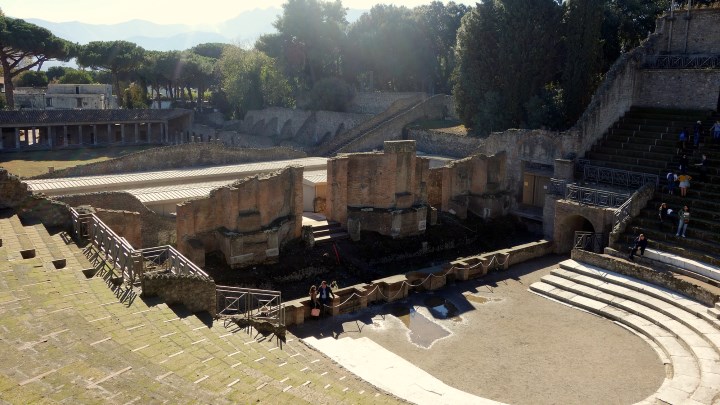
The theatre was the place where performances of comedies and tragedies were held. It included a semi-circular cavea from which led the series of steps divided into sections on which the spectators sat. Below was the area for the orchestra (the part intended for the chorus) and the scena, that is the stage where the actors performed. The theatre in Pompeii shows the features of Greek models in that it exploits the natural inclination of the terrain. The Roman-type theatre on the other hand depends on an architectural structure.
SMALL THEATRE OR ODEON
Established in the 1st century B.C., it represents one of the most harmonious and well-balanced examples of architecture of this type. It could hold up to 1,000 spectators and could be covered permanently. It is well preserved and shows the typical design of the Greek theatre with its structure deeply embanked in the natural slope of the terrain. It was used to host plays and musical events. In addition it was used for the performance of mimes.
Mime was a special theatrical performance of a comical or even bawdy nature, inspired by aspects and incidents of everyday life. Usually it only lasted for a short time.
The actors used masks as a rule and women were also admitted to the performance, which was not otherwise the case. Mime originated as farce in Sicily and was later modified in the Roman age.
LARGE THEATRE
This is a magnificent building constructed in the 2nd century B.C., with the stage area subsequently undergoing conversion. As a type it conforms to the Greek theatres in that the architectural structure adapts to the natural inclination of the terrain. During performances it could be covered, but it was not equipped with a permanent canopy, a privilege enjoyed by the Small Theatre. It had a remarkable capacity, being able to hold up to 5,000 spectators. Comedies and tragedies were acted here. A special feature of this theatre was the natural background which could be used as scenery: there is in fact a panoramic view across to the splendid ring of mountains which stand behind Pompeii. In the southern area of the Theatre there
was a colonnade set aside to accommodate the spectators during the intervals or at the end of the performance.



